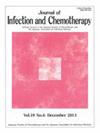Evaluation of outpatient antibiotic use using AWaRe and DDD/DOT indicators: A community pharmacy-based study in Nayoro City, Japan
IF 1.5
4区 医学
Q3 INFECTIOUS DISEASES
引用次数: 0
Abstract
Objective
This study evaluated outpatient antibiotic use in Nayoro City using the WHO AWaRe.
classification and DDD/DOT indicators. It assessed: (1) overall antibiotic use, (2) differences in Access group proportions by prescription duration, and (3) regional prescribing patterns in response to a confirmed drug shortage.
Methods
We retrospectively analyzed 32,632 outpatient prescriptions from July 2022 to March 2025. Short-term prescriptions (≤14 days) were extracted per national guidelines. Antibiotics were classified using the AWaRe framework, and DDDs were calculated. Cosine similarity assessed consistency across pharmacies. Following a cefaclor shortage in May 2024, changes in faropenem use were analyzed using Pearson's correlation, cross-correlation (CCF), vector autoregression (VAR), Welch's t-test, and interrupted time series (ITS) analysis.
Results
Short-term prescriptions comprised 81.1 % of all prescriptions. Access to antibiotics accounted for 33.2 % of all prescriptions and 27.2 % of short-term ones, considerably lower than the WHO's target of 60 %. Watch group antibiotics, especially second- and third-generation cephalosporins and fluoroquinolones, were predominantly prescribed for short-term use. Cefaclor alone represented 22.5 % of all prescriptions. After its shortage, the use of faropenem (Reserve group) significantly increased. Cosine similarity (≥0.85) confirmed consistent prescription patterns across pharmacies—antibiotic selection varied by prescription duration.
Conclusion
This study identified regional overuse of Watch antibiotics and a shift toward Reserve agents during drug shortages. Hospital formulary restrictions likely influenced citywide prescribing trends. These findings highlight the need for stable antibiotic supply chains, formulary review, and locally adapted antimicrobial stewardship strategies.
使用AWaRe和DDD/DOT指标评估门诊抗生素使用:日本Nayoro市一项基于社区药房的研究
目的应用世界卫生组织(WHO)的AWaRe对纳约罗市门诊抗生素使用情况进行评估。分类和DDD/DOT指标。它评估了:(1)总体抗生素使用情况,(2)按处方持续时间划分的可及组比例差异,以及(3)针对已确认的药物短缺的区域处方模式。方法回顾性分析2022年7月至2025年3月32632张门诊处方。短期处方(≤14天)按国家指南提取。采用AWaRe框架对抗生素进行分类,并计算DDDs。余弦相似性评估药房之间的一致性。继2024年5月头孢克洛短缺后,采用Pearson相关、交叉相关(CCF)、向量自回归(VAR)、Welch’st检验和中断时间序列(ITS)分析分析了法罗培南的使用变化。结果短期处方占处方总数的81.1%。获得抗生素占所有处方的33.2%,占短期处方的27.2%,大大低于世卫组织60%的目标。观察组抗生素,特别是第二代和第三代头孢菌素和氟喹诺酮类药物,主要用于短期使用。头孢克洛单独占所有处方的22.5%。在法罗培南(储备组)短缺后,其使用量显著增加。余弦相似度(≥0.85)证实了各药店处方模式的一致性——抗生素选择因处方持续时间而异。结论:本研究确定了局部地区过度使用Watch抗生素,并在药物短缺期间转向储备药物。医院的处方限制可能影响了全市的处方趋势。这些发现强调需要稳定的抗生素供应链、处方审查和适合当地的抗菌素管理战略。
本文章由计算机程序翻译,如有差异,请以英文原文为准。
求助全文
约1分钟内获得全文
求助全文
来源期刊

Journal of Infection and Chemotherapy
INFECTIOUS DISEASES-PHARMACOLOGY & PHARMACY
CiteScore
4.10
自引率
4.50%
发文量
303
审稿时长
47 days
期刊介绍:
The Journal of Infection and Chemotherapy (JIC) — official journal of the Japanese Society of Chemotherapy and The Japanese Association for Infectious Diseases — welcomes original papers, laboratory or clinical, as well as case reports, notes, committee reports, surveillance and guidelines from all parts of the world on all aspects of chemotherapy, covering the pathogenesis, diagnosis, treatment, and control of infection, including treatment with anticancer drugs. Experimental studies on animal models and pharmacokinetics, and reports on epidemiology and clinical trials are particularly welcome.
 求助内容:
求助内容: 应助结果提醒方式:
应助结果提醒方式:


